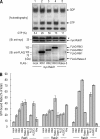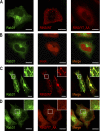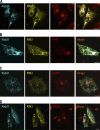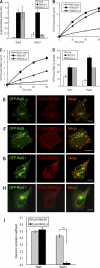Characterization of RIN3 as a guanine nucleotide exchange factor for the Rab5 subfamily GTPase Rab31
- PMID: 21586568
- PMCID: PMC3129215
- DOI: 10.1074/jbc.M110.172445
Characterization of RIN3 as a guanine nucleotide exchange factor for the Rab5 subfamily GTPase Rab31
Abstract
The small GTPase Rab5, which cycles between GDP-bound inactive and GTP-bound active forms, plays essential roles in membrane budding and trafficking in the early endocytic pathway. Rab5 is activated by various vacuolar protein sorting 9 (VPS9) domain-containing guanine nucleotide exchange factors. Rab21, Rab22, and Rab31 (members of the Rab5 subfamily) are also involved in the trafficking of early endosomes. Mechanisms controlling the activation Rab5 subfamily members remain unclear. RIN (Ras and Rab interactor) represents a family of multifunctional proteins that have a VPS9 domain in addition to Src homology 2 (SH2) and Ras association domains. We investigated whether RIN family members act as guanine nucleotide exchange factors (GEFs) for the Rab5 subfamily on biochemical and cell morphological levels. RIN3 stimulated the formation of GTP-bound Rab31 in cell-free and in cell GEF activity assays. RIN3 also formed enlarged vesicles and tubular structures, where it colocalized with Rab31 in HeLa cells. In contrast, RIN3 did not exhibit any apparent effects on Rab21. We also found that serine to alanine substitutions in the sequences between SH2 and RIN family homology domain of RIN3 specifically abolished its GEF action on Rab31 but not Rab5. We examined whether RIN3 affects localization of the cation-dependent mannose 6-phosphate receptor (CD-MPR), which is transported between trans-Golgi network and endocytic compartments. We found that RIN3 partially translocates CD-MPR from the trans-Golgi network to peripheral vesicles and that this is dependent on its Rab31-GEF activity. These results indicate that RIN3 specifically acts as a GEF for Rab31.
Figures







Similar articles
-
Tyr-phosphorylation signals translocate RIN3, the small GTPase Rab5-GEF, to early endocytic vesicles.Biochem Biophys Res Commun. 2008 Jul 18;372(1):168-72. doi: 10.1016/j.bbrc.2008.05.027. Epub 2008 May 16. Biochem Biophys Res Commun. 2008. PMID: 18486601
-
RIN3: a novel Rab5 GEF interacting with amphiphysin II involved in the early endocytic pathway.J Cell Sci. 2003 Oct 15;116(Pt 20):4159-68. doi: 10.1242/jcs.00718. J Cell Sci. 2003. PMID: 12972505
-
Engagement of the small GTPase Rab31 protein and its effector, early endosome antigen 1, is important for trafficking of the ligand-bound epidermal growth factor receptor from the early to the late endosome.J Biol Chem. 2014 May 2;289(18):12375-89. doi: 10.1074/jbc.M114.548321. Epub 2014 Mar 18. J Biol Chem. 2014. PMID: 24644286 Free PMC article.
-
Dysregulation of Rab5-mediated endocytic pathways in Alzheimer's disease.Traffic. 2018 Apr;19(4):253-262. doi: 10.1111/tra.12547. Epub 2018 Feb 5. Traffic. 2018. PMID: 29314494 Free PMC article. Review.
-
Ras and Rab Interactor 3: From Cellular Mechanisms to Human Diseases.Front Cell Dev Biol. 2022 Mar 14;10:824961. doi: 10.3389/fcell.2022.824961. eCollection 2022. Front Cell Dev Biol. 2022. PMID: 35359443 Free PMC article. Review.
Cited by
-
Amyloid precursor protein-mediated endocytic pathway disruption induces axonal dysfunction and neurodegeneration.J Clin Invest. 2016 May 2;126(5):1815-33. doi: 10.1172/JCI82409. Epub 2016 Apr 11. J Clin Invest. 2016. PMID: 27064279 Free PMC article.
-
Rab31 expression levels modulate tumor-relevant characteristics of breast cancer cells.Mol Cancer. 2012 Aug 24;11:62. doi: 10.1186/1476-4598-11-62. Mol Cancer. 2012. PMID: 22920728 Free PMC article.
-
Early-Onset Alzheimer Disease and Candidate Risk Genes Involved in Endolysosomal Transport.JAMA Neurol. 2017 Sep 1;74(9):1113-1122. doi: 10.1001/jamaneurol.2017.1518. JAMA Neurol. 2017. PMID: 28738127 Free PMC article.
-
Dissecting the causal effects of smoking, alcohol consumption, and related DNA methylation markers on electrocardiographic indices.Clin Epigenetics. 2025 Mar 4;17(1):40. doi: 10.1186/s13148-025-01851-x. Clin Epigenetics. 2025. PMID: 40038836 Free PMC article.
-
Genetic architectures of proximal and distal colorectal cancer are partly distinct.Gut. 2021 Jul;70(7):1325-1334. doi: 10.1136/gutjnl-2020-321534. Epub 2021 Feb 25. Gut. 2021. PMID: 33632709 Free PMC article.
References
Publication types
MeSH terms
Substances
LinkOut - more resources
Full Text Sources
Molecular Biology Databases
Miscellaneous

